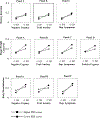The effects of puberty on associations between mood/personality factors and disordered eating symptoms in girls
- PMID: 34165208
- PMCID: PMC8609476
- DOI: 10.1002/eat.23572
The effects of puberty on associations between mood/personality factors and disordered eating symptoms in girls
Abstract
Objective: Negative and positive urgency, anxiety, and depressive symptoms are significant factors of disordered eating (DE) symptoms in early adolescence through young adulthood. However, it is unclear how puberty-a critical developmental milestone that is associated with increased risk for DE symptoms-affects the relationship between these factors and DE symptoms, given that the role of pubertal status has rarely been considered in relation to these associations. Thus, the present study examined whether puberty moderates associations between mood/personality factors and DE in pre-adolescent and adolescent girls.
Method: Participants included 981 girls (aged 8-16 years) from the Michigan State University Twin Registry. Mood/personality factors, pubertal status, and DE were assessed with self-report questionnaires.
Results: Puberty significantly moderated associations between several factors (negative urgency, positive urgency, trait anxiety, depressive symptoms) and the cognitive symptoms of DE (e.g., shape/weight concerns, body dissatisfaction). Associations between mood/personality factors and cognitive DE were stronger in girls with more advanced pubertal status. By contrast, no significant moderation effects were detected for mood/personality-dysregulated eating (e.g., binge eating, emotional eating) associations.
Discussion: Findings identify pubertal development as an important moderator of mood/personality-DE symptom associations, especially for cognitive DE symptoms that are known to predict the later onset of clinical pathology.
Keywords: body dissatisfaction; depressive symptoms; dietary restraint; negative urgency; positive urgency; puberty; shape/weight concerns; trait anxiety.
© 2021 Wiley Periodicals LLC.
Figures
Similar articles
-
Estrogen moderation of genetic influences on eating disorder symptoms during gonadarche in girls: Specific effects on binge eating.Psychoneuroendocrinology. 2023 Dec;158:106384. doi: 10.1016/j.psyneuen.2023.106384. Epub 2023 Sep 6. Psychoneuroendocrinology. 2023. PMID: 37708824 Free PMC article.
-
An investigation of associations between parenting and binge eating across pubertal development in pre-adolescent and adolescent female participants.Int J Eat Disord. 2022 Dec;55(12):1811-1823. doi: 10.1002/eat.23818. Epub 2022 Oct 5. Int J Eat Disord. 2022. PMID: 36199233 Free PMC article.
-
Differences in genetic and environmental influences on body weight and shape concerns across pubertal development in females.J Psychiatr Res. 2020 Feb;121:39-46. doi: 10.1016/j.jpsychires.2019.11.001. Epub 2019 Nov 8. J Psychiatr Res. 2020. PMID: 31759219 Free PMC article.
-
Puberty as a critical risk period for eating disorders: a review of human and animal studies.Horm Behav. 2013 Jul;64(2):399-410. doi: 10.1016/j.yhbeh.2013.02.019. Horm Behav. 2013. PMID: 23998681 Free PMC article. Review.
-
[Psychopathology related to women pubertal precocity].Encephale. 2016 Oct;42(5):453-457. doi: 10.1016/j.encep.2015.06.006. Epub 2016 May 16. Encephale. 2016. PMID: 27198075 Review. French.
Cited by
-
Estrogen moderation of genetic influences on eating disorder symptoms during gonadarche in girls: Specific effects on binge eating.Psychoneuroendocrinology. 2023 Dec;158:106384. doi: 10.1016/j.psyneuen.2023.106384. Epub 2023 Sep 6. Psychoneuroendocrinology. 2023. PMID: 37708824 Free PMC article.
-
Exploring the possibility of parents' broad internalizing phenotype acting through passive gene-environment correlations on daughters' disordered eating.Dev Psychopathol. 2022 Dec;34(5):1744-1755. doi: 10.1017/S0954579422000608. Epub 2022 Aug 19. Dev Psychopathol. 2022. PMID: 35983803 Free PMC article.
-
An investigation of associations between parenting and binge eating across pubertal development in pre-adolescent and adolescent female participants.Int J Eat Disord. 2022 Dec;55(12):1811-1823. doi: 10.1002/eat.23818. Epub 2022 Oct 5. Int J Eat Disord. 2022. PMID: 36199233 Free PMC article.
-
Cultural Determinants of Body Image: What About the Menopausal Transition?Healthcare (Basel). 2025 Jan 3;13(1):76. doi: 10.3390/healthcare13010076. Healthcare (Basel). 2025. PMID: 39791683 Free PMC article. Review.
-
Advocacy through storytelling: challenging eating disorders and eating disorders stigma.J Eat Disord. 2024 Sep 19;12(1):145. doi: 10.1186/s40337-024-01099-5. J Eat Disord. 2024. PMID: 39300517 Free PMC article.
References
-
- Adams PJ, Katz RC, Beauchamp K, Cohen E, & Zavis D. (1993). Body dissatisfaction, eating disorders, and depression: A developmental perspective. Journal of Child and Family Studies, 2(1), 37–46. doi:10.1007/BF01321299 - DOI
-
- Binford RB, Le Grange D, & Jellar CC (2004). Eating Disorders Examination versus Eating Disorders Examination-Questionnaire in adolescents with full and partial-syndrome bulimia nervosa and anorexia nervosa. International Journal of Eating Disorders, 37(1), 44–49. doi:10.1002/eat.20062 - DOI - PubMed
Publication types
MeSH terms
Grants and funding
LinkOut - more resources
Full Text Sources
Medical


